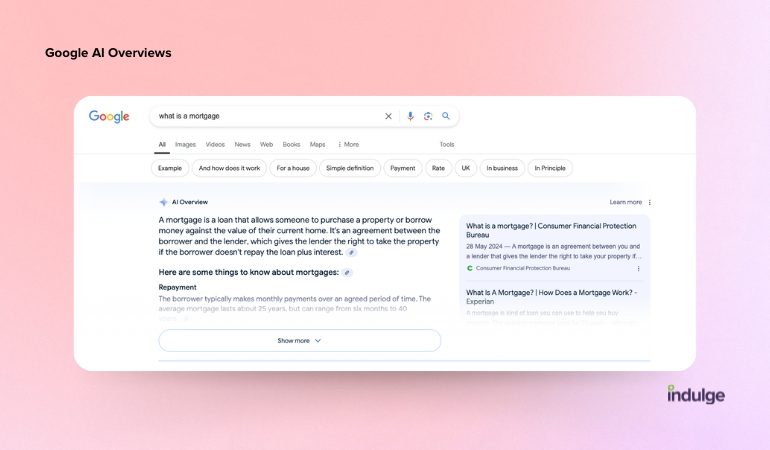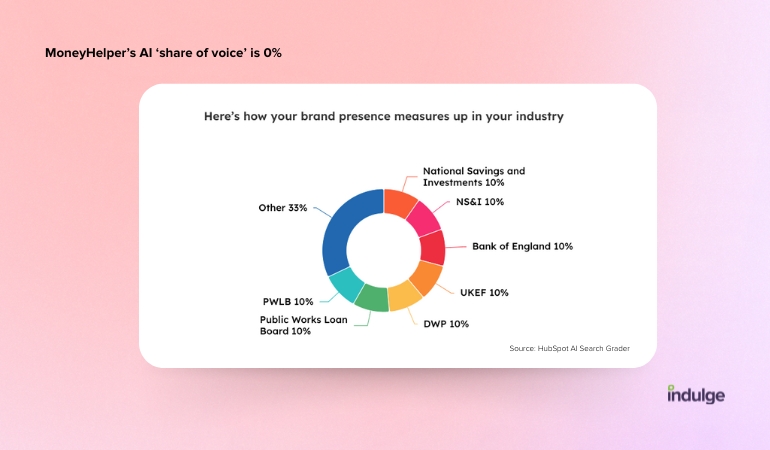How do you track the impact of AIO?
Tracking your brand’s visibility on AI-driven search tools will be a new challenge.
Tracking visibility on classic search engines (Google, Bing, etc.) is challenging enough. Fundamentally, search rankings are only generated when a person performs a search.
Google considers what the person has searched for and the context surrounding the search (where they are, what they like etc).
Only then does Google list the results. Whilst we all chase ‘number one rankings’, there isn’t really any such thing.
All there is is an increased likelihood of appearing at the top of the search results for your target audience.
AI changes the game; moving forward, more searches will be answered in a range of formats, not just a sequential, prioritised list of results.
What does AI search look like today, in 2024?
I added ‘in 2024’ to this section because it will be wrong in a few months.
Today, as I write this article, AI search for the average person looks like one of three things below. This by no means tells the whole story, there are more AI search tools out there, but the ones that your friends are using probably fall into one of these categories.
Classic search with AI added
Google has launched AI Overviews, Bing has launched Copilot.
Google AI Overviews are perhaps the most tightly integrated into its classic search engine. It looks like this:

For selected searches, the search results page will begin with a new section at the top. In Google’s own words, AI Overviews provide “an AI-generated snapshot with key information and links to dig deeper.”
If you’ve used ChatGPT, it’s like having a version of that on the Google results page.
An AI search engine
If you’re the ‘bleeding edge technology’ type, you’ve probably tried Perplexity. Perplexity is an AI-driven search engine that’s “designed to provide users with accurate, real-time answers to their queries by leveraging artificial intelligence and natural language processing,” so says its own search result.
A user can ask it a question and it will provide an answer as well as links to source information in order to find out more.
On-device helpers
The third category of everyday AI search tools that exist right now is your on-device helper. Siri, Alexa, Gemini, Copilot.
Each of these is in a different state of evolution; Apple, for instance, has announced sweeping changes to Siri with Apple Intelligence, it has launched new AI-ready devices (iPhone 16), but is yet to actually launch the new version of Siri.
Regardless, now and increasingly moving forward, the average person will learn to turn to their smart device and ask it questions it once would have asked Google or Bing.
So who ranks number one?
Tracking SEO performance has historically focussed on rankings. The details have evolved over time; it’s more about ‘visibility’ for a topic in general rather than a ranking for an individual keyword, but the model has focussed on showing up on the results page.
Traffic from search has remained a key metric as well, as has the resulting outcomes from said traffic.
So, how does one track performance from AI-driven search?
Ignoring what’s actually possible right now, in an ideal world, we’ll be able to monitor:
- Brand mentions
- Link/source impressions
- Link/source clicks
This will enable us to see how often our brand is referenced in an AI search result, how often a piece of our content is shown and how often it’s clicked.
In reality, we can currently see a lot less.
How to track AIO performance
AI Overviews are shown at the top of 28% of all searches. It was at around 13% in June, so it’s growing.
It is possible to track AIO performance. Given that Google retains somewhere in the region of 90% of global search market share, it’s fair to focus tracking efforts here in the first instance.
According to data in the US (where Google’s AI Overviews first launched) from AWR, AI Overviews are shown at the top of 28% of all searches. It was at around 13% in June, so it’s growing.
By sector, in the US, AI Overviews are shown on the following percentage of searches:
- Finance - 27%
- Insurance - 5%
- Investment - 7%
- Legal - 32%
The vast majority of AI Overview use at present focuses on ‘informational’ searches. This means that Google is using this tool as a way to answer research-type queries that users search for.
In this context, it perhaps makes sense that more finance and legal searches contain AI Overviews, where the search is often research-led. Likewise, insurance and investment, two very commercially driven areas of search trigger AI Overviews less often.
As things stand, multiple search tracking tools have begun integrating AI Overview tracking into their systems.
Both SEMrush and SEOmonitor enable users to see which keywords trigger an AI Overview feature, and where your brand is featured. It remains to be seen how reliable these tools are, but it’s a start.
More widely, HubSpot has launched a ChatGPT-powered AI Search Grader tool that can uncover a brand’s ‘share of voice’ within ChatGPT sessions.
Here’s MoneyHelper’s report:

The beginning
Online performance tracking is already going through a change. As devices and browsers begin to block tracking cookies by default, a brand’s ability to monitor everything that happens is being squeezed.
The launch of AI-powered tools is going to change things even more. The emphasis is going to be on monitoring brand notoriety and we’re going to see an explosion of new tools to help do this.




